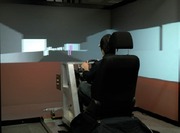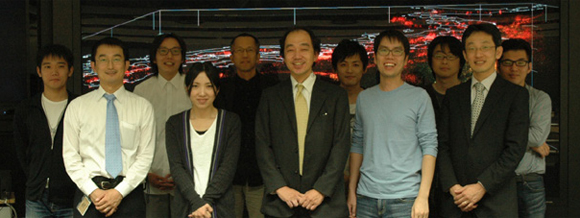 Group photograph in front of the CDF system
Group photograph in front of the CDF system
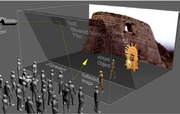 Digital museum making use of immersive augmented reality technology
Digital museum making use of immersive augmented reality technology
The development of faster, more compact computers, the spread of broadband networks and the use of three-dimensional imaging have brought extraordinary changes to telecommunication systems and media environments. The research in this laboratory takes a broad perspective on systems design, ranging from human interfaces, virtual realities, realistic communication and other communications media technologies to the application of visual simulation in social systems. Below are some of the recent research topics.
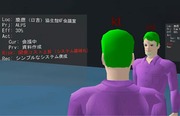 Project management making use of cyber-space
Project management making use of cyber-space
Immersive display technologies
Immersive displays use large screens and high-definition 3-D video to create extremely realistic, immersive visual spaces. Development projects include a cave made up of surround screens, a "CDF" super-high resolution display using 4K 3-D video, the "AR View" augmented reality display using large half mirrors, and tiled displays made up of multiple LCD panels. These immersive displays are capable of life-size expression of three-dimensional video, and therefore enable the visualization of design models and simulation results. They can also be used effectively as data mining environments.
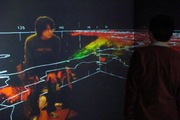 Visualization of seismic data using tele-immersion environments
Visualization of seismic data using tele-immersion environments
Realistic communications technologies
Immersive display environments can be networked to achieve highly realistic space sharing. This kind of technology is called "tele-immersion," and it is looked to for the next generation of communications environments. Research on techniques for achieving ultra-realistic communication in shared virtual spaces includes video avatars that synthesize shared virtual spaces from mutual transmissions of video images among users and data sharing technologies for shared virtual spaces. Tele-immersion technology will have applications in facilitating realistic meetings, collaborative work and distance learning between remote locations.
Design of data communications media systems
This is applied research into the design of the next generation of data communication systems and media systems. A wide range of projects have been taken up, including a digital museum using immersive augmented reality technology, a three-dimensional planetarium using spatial images based on the layer segmentation method, a project management system that makes use of cyber-space, visualization of seismic data using tele-immersion environments, digital signage using tiled displays, real time safety network systems, emergency life-saving system simulation and immersive driving simulators for the elderly.
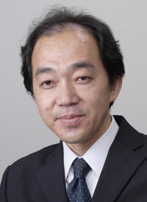
Professor Tetsuro Ogi
http://lab.sdm.keio.ac.jp/ogi/
Researcher at Mitsubishi Research Institute, associate professor at University of Tokyo and Associate Professor at University of Tsukuba before taking up his present post
Areas of expertise: human interface, virtual reality, realistic communication and visual simulation
Publications: "Introduction to Cyber-Space" (Nippon Jitsugyo Publishing) and "Thoughts on Simulation" (University of Tokyo Press) and more.
